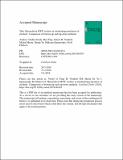Files in this item
Hierarchical MTW zeolites in tetrahydropyranylation of alcohols : comparison of bottom-up and top-down methods
Item metadata
| dc.contributor.author | Veselý, Ondřej | |
| dc.contributor.author | Pang, Hao | |
| dc.contributor.author | Vornholt, Simon M. | |
| dc.contributor.author | Mazur, Michal | |
| dc.contributor.author | Yu, Jihong | |
| dc.contributor.author | Opanasenko, Maksym | |
| dc.contributor.author | Eliášová, Pavla | |
| dc.date.accessioned | 2019-06-14T23:40:38Z | |
| dc.date.available | 2019-06-14T23:40:38Z | |
| dc.date.issued | 2019-03-01 | |
| dc.identifier | 253391176 | |
| dc.identifier | 64bc4580-00a5-4ecf-8fa3-f7693b0cc488 | |
| dc.identifier | 85048576411 | |
| dc.identifier | 000456316500016 | |
| dc.identifier.citation | Veselý , O , Pang , H , Vornholt , S M , Mazur , M , Yu , J , Opanasenko , M & Eliášová , P 2019 , ' Hierarchical MTW zeolites in tetrahydropyranylation of alcohols : comparison of bottom-up and top-down methods ' , Catalysis Today , vol. 324 , pp. 123-134 . https://doi.org/10.1016/j.cattod.2018.06.010 | en |
| dc.identifier.issn | 0920-5861 | |
| dc.identifier.other | RIS: urn:0D6887884EC5E4827FFFF5A6EAD5A264 | |
| dc.identifier.uri | https://hdl.handle.net/10023/17901 | |
| dc.description | Authors thank the Czech Science Foundation for financial support (17-06524Y). H.P. and J.Y. thank to the 111 project of the Ministry of Education of China (B17020). M.M. and S.M.V. acknowledge the support of EPSRC grant EP/K025112/1 and Capital for Great Technologies Grant EP/L017008/1. | en |
| dc.description.abstract | Despite a widespread application of zeolites in catalysis, these microporous materials still suffer from a low accessibility of active sites located deep in crystals due to limited size of channels (< 1 nm). Here, we prepared a series of micro-mesoporous zeolites with MTW topology and similar Si/Al molar ratio (50). Two topical approaches were applied here: i. bottom-up synthesis with a surfactant-SDA leading to so-called nanosponge material; ii. top-down desilication of bulk crystals by NaOH solution in the presence of tetraalkylammonium cations (TAA+). Prepared materials were characterized by powder X-ray diffraction, sorption of nitrogen, adsorption of pyridine and di-tert-butyl-pyridine followed by FTIR, solid state 27Al NMR, ICP-OES, SEM, TEM, and STEM-EDS. It was found that the desilication of MTW in the presence of TAA+ proceeds in different pathway compared to well-studied MFI. This variance was attributed to the different dimensionality of their channel systems (1D vs. 3D). Materials were tested in tetrahydropyranylation of alcohols differing in a chain length and degree of branching. The nanosponge MTW shows generally very good performance. Nevertheless, in cases of the branched alcohols MTW materials desilicated in the presence of TAA+ exhibited comparable or even higher activity than nanosponge based on TOF values. Therefore, desilicated MTW presents cheaper and equally or more effective catalyst compared to nanosponge material with the same topology. | |
| dc.format.extent | 2420682 | |
| dc.language.iso | eng | |
| dc.relation.ispartof | Catalysis Today | en |
| dc.subject | Zeolite | en |
| dc.subject | MTW | en |
| dc.subject | Hierarchical porosity | en |
| dc.subject | Tetrahydropyranylation of alcohols | en |
| dc.subject | Nanosponge | en |
| dc.subject | Desilication | en |
| dc.subject | QD Chemistry | en |
| dc.subject | NDAS | en |
| dc.subject.lcc | QD | en |
| dc.title | Hierarchical MTW zeolites in tetrahydropyranylation of alcohols : comparison of bottom-up and top-down methods | en |
| dc.type | Journal article | en |
| dc.contributor.sponsor | EPSRC | en |
| dc.contributor.institution | University of St Andrews. School of Chemistry | en |
| dc.identifier.doi | 10.1016/j.cattod.2018.06.010 | |
| dc.description.status | Peer reviewed | en |
| dc.date.embargoedUntil | 2019-06-15 | |
| dc.identifier.grantnumber | EP/K025112/1 | en |
This item appears in the following Collection(s)
Items in the St Andrews Research Repository are protected by copyright, with all rights reserved, unless otherwise indicated.

